AMD Dives Deep On High Bandwidth Memory - What Will HBM Bring AMD?
by Ryan Smith on May 19, 2015 8:40 AM ESTThe Net Benefits of HBM
Now that we’ve had a chance to talk about how HBM is constructed and the technical hurdles in building it, we can finally get to the subject of the performance and design benefits of HBM. HBM is of course first and foremost about further increasing memory bandwidth, but the combination of stacked DRAM and lower power consumption also opens up some additional possibilities that could not be pursued with GDDR5.
We’ll start with the bandwidth capabilities of HBM. The amount of bandwidth ultimately depends on the number of stacks in use along with the clockspeed of those stacks. HBM uses a DDR signaling interface, and while AMD is not disclosing final product specifications at this time, they have given us enough information to begin to build a complete picture.
| GPU Memory Math | |||||
| AMD Radeon R9 290X | NVIDIA GeForce GTX Titan X | Theoretical 4-Stack HBM1 | |||
| Total Capacity | 4GB | 12GB | 4GB | ||
| Bandwidth Per Pin | 5Gbps | 7Gbps | 1Gbps | ||
| Number of Chips/Stacks | 16 | 24 | 4 | ||
| Bandwidth Per Chip/Stack | 20GB/sec | 14GB/sec | 128GB/sec | ||
| Effective Bus Width | 512-bit | 384-bit | 4096-bit | ||
| Total Bandwidth | 320GB/sec | 336GB/sec | 512GB/sec | ||
| Estimated DRAM Power Consumption |
30W | 31.5W | 14.6W | ||
The first generation of HBM AMD is using allows for each stack to be clocked up to 500MHz, which after DDR signaling leads to 1Gbps per pin. For a 1024-bit stack this means a single stack can deliver up to 128GB/sec (1024b * 1G / 8b) of memory bandwidth. HBM in turn allows from 2 to 8 stacks to be used, with each stack carrying 1GB of DRAM. AMD’s example diagrams so far (along with NVIDIA’s Pascal test vehicle) have all been drawn with 4 stacks, in which case we’d be looking at 512GB/sec of memory bandwidth. This of course is quite a bit more than the 320GB/sec of memory bandwidth for the R9 290X or 336GB/sec for NVIDIA’s GTX titan X, working out to a 52-60% increase in memory bandwidth.
At the same time this also calls into question memory capacity – 4 1GB stacks is only 4GB of VRAM – though AMD seems to be saving that matter for the final product introduction later this quarter. Launching a new, high-end GPU with 4GB could be a big problem for AMD, but we'll see just what they have up their sleeves in due time.
What’s perhaps more interesting is what happens to DRAM energy consumption with HBM. As we mentioned before, R9 290X spends 15-20% of its 250W power budget on DRAM, or roughly 38-50W of power on an absolute basis. Meanwhile by AMD’s own reckoning, GDDR5 is good for 10.66GB/sec of bandwidth per watt of power, which works out to 30W+ via that calculation. HBM on the other hand delivers better than 35GB/sec of bandwidth per watt, an immediate 3x gain in energy efficiency per watt.
Of course AMD is then investing some of those gains back in to coming up with more memory bandwidth, so it’s not as simple as saying that memory power consumption has been cut by 70%. Rather given our earlier bandwidth estimate of 512GB/sec of memory bandwidth for a 4 stack configuration, we would be looking at about 15W of power consumption for a 512GB/sec HBM solution, versus 30W+ for a 320GB/sec GDDR5 solution. The end result then points to DRAM power consumption being closer to halved, with AMD saving 15-20W of power.
What’s the real-world advantage of a 15-20W reduction in DRAM power consumption? Besides being able to invest that in reducing overall video card power consumption, the other option is to invest it in increasing clockspeeds. With PowerTune putting a hard limit on power consumption, a larger GPU power budget would allow AMD to increase clockspeeds and/or run at the maximum GPU clockspeed more often, improving performance by a currently indeterminable amount. Now as fair warning here, higher GPU clockspeeds typically require higher voltages, which in turn leads to a rapid increase in GPU power consumption. So although having additional power headroom does help the GPU, it may not be good for quite as much of a clockspeed increase as one might hope.
Meanwhile the performance increase from the additional memory bandwidth is equally nebulous until AMD’s new product is announced and benchmarked. As a rule of thumb GPUs are virtually always memory bandwidth bottlenecked – they are after all high-throughput processors capable of trillions of calculations per second working with only hundreds of billions of bytes of bandwidth – so there is no doubt that the higher memory bandwidths of HBM will improve performance. However memory bandwidth increases currently don’t lead to 1:1 performance increases even on AMD’s current cards, and it’s unlikely to be any different on future products.
Throwing an extra wrinkle into matters, any new AMD product would be based on GCN 1.2 or newer, which introduced AMD’s latest generation of color compression technology. The net result is that on identical workloads, memory bandwidth pressure is going down exactly at the same time as memory bandwidth availability is going up. AMD will end up gaining a ton of effective memory bandwidth – something that will be very handy for high resolutions – but it also makes it impossible to predict what the final performance impact might be. Still, it will be interesting to see what AMD can do with a 2x+ increase in effective memory bandwidth for graphics workloads.
The final major benefit AMD is looking at taking advantage of with HBM – and that this point they’re not even being subtle about – is new form factor designs from the denser designs enabled by HBM. With the large GDDR5 memory chips replaced with much narrower HBM stacks, AMD is telling us that the resulting ASIC + RAM setups can be much smaller.
How much smaller? Well 1GB of GDDR5, composed of 2Gbit modules (the standard module size for R9 290X) would take up 672mm2, versus just 35mm2 for the same 1GB of DRAM as an HBM stack. Even if we refactor this calculation for 4Gbit modules – the largest modules used in currently shipping video cards – then we still end up with 336mm2 versus 35mm2, which is still a savings of 89% for 1GB of DRAM. Ultimately the HBM stack itself is composed of multiple DRAM dies, so there’s still quite a bit of silicon in play, however its 2D footprint is reduced significantly thanks to stacking.
By AMD’s own estimate, a single HBM-equipped GPU package would be less than 70mm X 70mm (4900mm2), versus 110mm X 90mm (9900mm2) for R9 290X. Throw in additional space savings from the fact that HBM stacks don’t require quite as complex power delivery circuitry, and the card space savings could be significant. By our reckoning the total card size will still be fairly big – all of those VRMs and connectors need to go somewhere – but there is potential for significant savings. What AMD intends to do with those savings remains to be seen, but with apologies to AMD on this one, NVIDIA has already shown off their Pascal test vehicle for their mezzanine connector design, and it goes without saying that such a form factor opens up some very interesting possibilities.
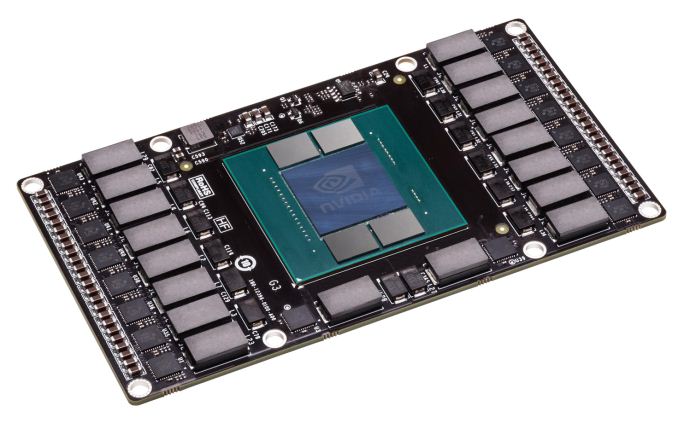
With apologies to AMD: NVIDIA’s Pascal Test Vehicle, An Example Of A Smaller, Non-Traditional Video Card Design
Finally, aftermarket enthusiasts may or may not enjoy one final benefit from the use of HBM. Because the DRAM and GPU are now on the same package, AMD is going to be capping the package with an integrated heat spreader (IHS) to compensate for any differences in height between the HBM stacks and GPU die, to protect the HBM stacks, and to supply the HBM stacks with sufficient cooling. High-end GPU dies have been bare for some time now, so an IHS brings with it the same kind of protection for the die that IHSs brought to CPUs. At the same time however this means it’s no longer possible to make direct contact with the GPU, so extreme overclockers may come away disappointed. We’ll have to see what the shipping products are like and whether in those cases it’s viable to remove the IHS.
Closing Thoughts
Bringing this deep dive to a close, as the first GPU manufacturer to be shipping an HBM solution – in fact AMD expects to be the only vendor to ship an HBM1 solution – AMD has set into motion some very aggressive product goals thanks to the gains from HBM. Until we know more about AMD’s forthcoming video card I find it prudent to keep expectations in check here, as HBM is just one piece of the complete puzzle that is a GPU. But at the same time let’s be clear here: HBM is the future memory technology of GPUs, there is potential for significant performance increases thanks to the massive increase in memory bandwidth offers, and for roughly the next year AMD is going to be the only GPU vendor offering this technology.
AMD for their part is looking to take as much of an advantage of their lead as they can, both at the technical level and the consumer level. At the technical level AMD has said very little about performance so far, so we’ll have to wait and see just what their new product brings. But AMD is being far more open about their plans to exploit the size advantage of HBM, so we should expect to see some non-traditional designs for high-end GPUs. Meanwhile at the consumer level, expect to see HBM enter the technology lexicon as the latest buzzword for high-performance products – almost certainly to be stamped on video card boxes today just as GDDR5 has been for years – as AMD looks to let everyone know about their advantage.
Meanwhile shifting gears towards the long term, high-end GPUs are just the first of what AMD expects to be a wider rollout for HBM. Though AMD is not committing to any other products at this time, as production ramps up and costs come down, HBM is expected to become financially viable in a wider range, including lower-end GPUs, HPC products (e.g. FirePro S and AMD’s forthcoming HPC APU), high-end communications gear, and of course AMD’s mainstream consumer APUs. As lower-margin products consumer APUs will likely be among the farthest off, however in the long-run they may very well be the most interesting use case for HBM, as APUs are among the most bandwidth-starved graphics products out there. But before we get too far ahead of ourselves, let’s see what AMD is able to do with HBM on their high-end video cards later this quarter.


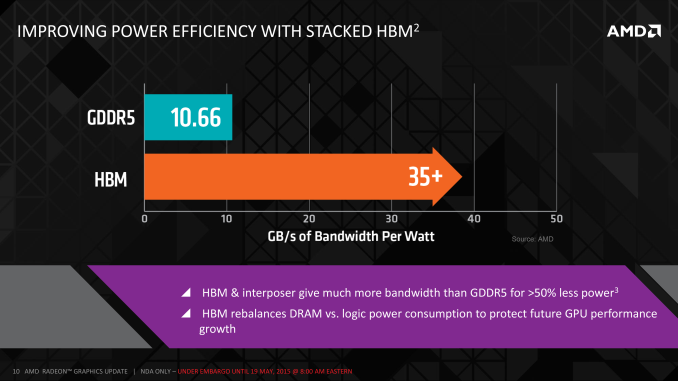
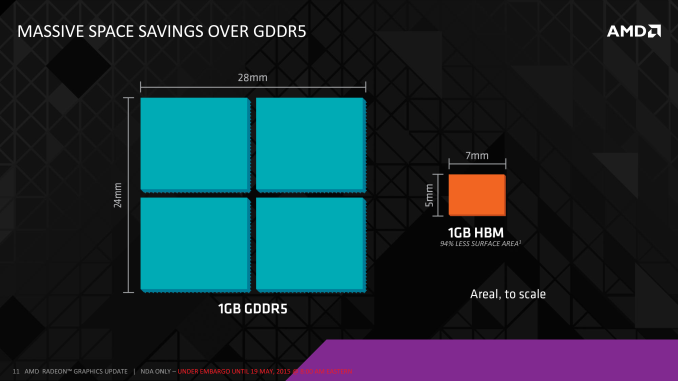
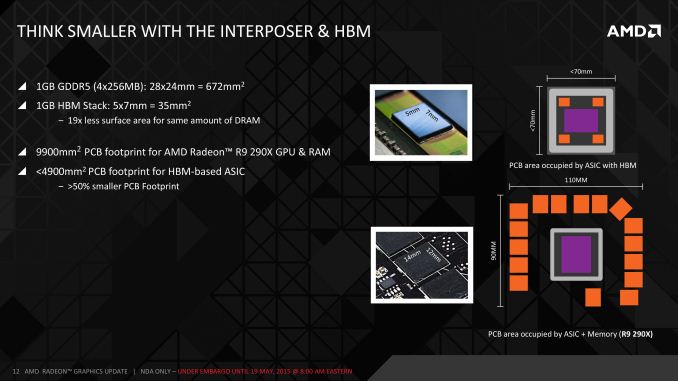
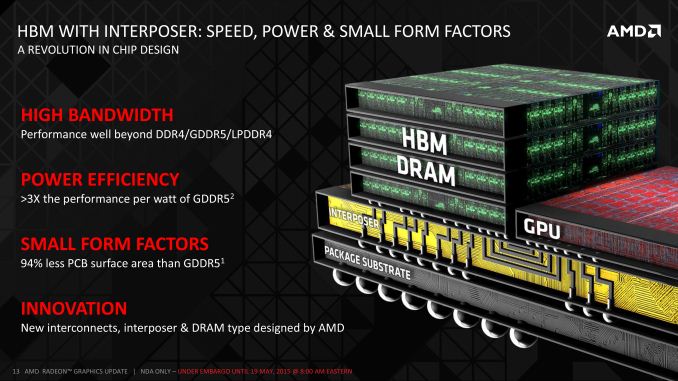








163 Comments
View All Comments
ravyne - Tuesday, May 19, 2015 - link
No, not necessarily. AMD isn't exactly allaying any fears by remaining silent so far, but there's a method for chaining two HBM chips together, similar to how chip-select works in normal DDR RAM or SRAMs in embedded systems -- basically you have two chips sharing that 1024-bit memory bus, but there's a separate control signal that indicates which chip the host is talking to. In theory you can chain things along forever with enough chip selects, but a high-performance and highly-parallel bus like HBM is practically limited by signal-propagation latency and misalignment, so using just two chips per HBM bus is more of a practical limitation.looncraz - Tuesday, May 19, 2015 - link
Nope, at least not according to my understanding. In fact, in theory, HBM1 can be configured, at reduced speeds, at well over 8GB. The article even mentions a technical bit of information pertaining to this:"HBM in turn allows from 2 to 8 stacks to be used, with each stack carrying 1GB of DRAM."
From 2GB to 8GB right there, without any trickery. It appears HBM chips need to be used in pairs (otherwise a 2 chip minimum makes no sense), and likely needs to be addressed in pairs (with a 512-bit bus per chip, it would seem). This would indicate there is a two-bit address line which allows from one to four pairs to be individually addressed, or perhaps four binary address lines, whichever they deemed to be more economical and prudent. Either way it appears each stack has a 512-bit data bus.
If correct, you can even use a single 1024-bit bus and interleave on the bus and address 8GB @ 128GB/s maximum. A 2048-bit bus would limit at 16GB @ 256 GB/s, a 3072-bit bus could use 24GB @ 384GB/s, and a 4096-bit bus could use 32GB @ 512GB/s. Interleaving on the bus, though, would increase latency and decrease throughput.
That said, no company, especially not AMD, would design and then bet big on a memory technology that limited them to 4GB without having a solution ready. Everything I mentioned that the HBM chips would be required to support are standard for memory chips made for the last many many decades and was probably included even in the first rough draft for the command protocol without anyone even thinking about it twice. That's just how it works.
It might even be possible to use an 512-bit bus and some latching circuitry to drive HBM. You might even be able to do this with good performance and high capacities without modifying the memory chips at all.
chizow - Wednesday, May 20, 2015 - link
All sounds really good in theory, unfortunately none of the (substantial) source material from AMD/Hynix supports this, nor do the comments from the AMD VP Macri who seems more or less resigned to the fact AMD is going forward with 4GB for HBM1.But in any case, hopefully you won't be too disappointed if it is only 4GB.
looncraz - Wednesday, May 20, 2015 - link
Your comment made me remember that the standard was submitted to JEDEC.JESD235 pertains to HBM (v1), from it I was able to determine that if 8GB was to be supported using 1GB stacks the command interface would have to be duplicated per chip, but the (much larger) data bus could be shared - with some important timing caveats, of course, but that is nothing new for memory controllers (in fact, that is most of what they do), but it is not necessarily something you'd want to do without having already had a working product using the memory technology... and certainly not something you'd bother implementing if you expected higher capacity chips to be available in a year's time...
I finally see how HBM works internally (something that's been lacking from most "technical" articles), and I see why its external interface doesn't follow convention - it's basically an 8/16 bank "up to 8 channel" collection of DRAM chips. Each channel can be addressed separately with a 128-bit data bus and can support 32Gb (4GB) of DRAM.
So HBM uses the relevant addressing lines internally, if at all (vendor specific), and doesn't provide for such a mechanism externally.
From what I'm seeing, it would seem you can build HBM with any width you want, in intervals of 128-bits. Of course, standards are designed to be flexible. That could mean lower powered devices could use 256bit HBM interfaces to save power... unless I'm totally missing something (which is quite likely, it isn't like reading a standards document is the same as reading a quick overview ;-)).
chizow - Thursday, May 21, 2015 - link
Yep exactly, that's where the original 4GB limits for HBM1 came from originally, the JEDEC/Hynix source documents.akamateau - Thursday, May 28, 2015 - link
With Highbandwidth memory depth is not necessary. Of course only the benchmarks will actually show us.And of course DX11 will be useless for this product. HBM was designed to solve a problem! DX12 solves the CPU bottleneck however DX12 benchmarks shows that performance scale sup nicely to 20MILLION + draw calls per second with 6 CPU cores feeding the GPU. When the CPU has 8 coress the performance flatlines and does not get anybetter.
ANAND demonstrated this quite clearly a few weeks back. However HBM will scael far beyond 6 cores as their is more through-put.
Of course that would mean that 390x must be benched using DX12 benchmarks. But that is what they were designed for: Mantle and DX12
akamateau - Thursday, May 28, 2015 - link
You do not need the memory depth with HBM.HBM was designed to solve a problem that becomes apparent with DX12. DX11 does not support multithreaded and multicore gaming. DX12 enables ALL CPU cores to feed the GPU through Asynchronous Shader Pipelines and Asynchronous Compute Engines.
With DX12 GPU performance scales well to 6 cpu cores, beyond that and the GPU drawcall perfomance flatlines: GPU bottleneck. HBM will solve this problem.
DX11 is such a crippling API that anyone even using it to make a decision regarding a $1000 GPU purchase will lkely waste their money.
With DX12 Benching Radeon 390x with HBM will demostrate 400-500% performance increases over DX11.
Do you want to know the facts before you spend your money? Then demand DX12 benchmarks!!
akamateau - Thursday, May 28, 2015 - link
According to AMD's Joe Macri, GDDR5 fed GPUs actually have too much unused memory today. Because to increase GPU memory bandwidth, wider memory interfaces are used. And because wider memory interfaces require a larger amount of GDDR5 memory chips, GPUs ended up with more memory capacity than is actually needed.Macri also stated that AMD invested a lot into improving utilization of the frame buffer. This could include on-die memory compression techniques which are integrated into the GPU hardware itself. Or more clever algorithms on the driver level."http://wccftech.com/amd-addresses-capacity-limitat...
DX11 will not likely allow an HBM AIB to show much of an improvement in performance. Run DX12 games or benchmarks and HBM will rock that AIB!
akamateau - Thursday, May 28, 2015 - link
You do not need the memory depth with HBM.HBM was designed to solve a problem that becomes apparent with DX12. DX11 does not support multithreaded and multicore gaming. DX12 enables ALL CPU cores to feed the GPU through Asynchronous Shader Pipelines and Asynchronous Compute Engines.
With DX12 GPU performance scales well to 6 cpu cores, beyond that and the GPU drawcall perfomance flatlines: GPU bottleneck. HBM will solve this problem.
DX11 is such a crippling API that anyone even using it to make a decision regarding a $1000 GPU purchase will lkely waste their money.
With DX12 Benching Radeon 390x with HBM will demostrate 400-500% performance increases over DX11.
Do you want to know the facts before you spend your money? Then demand DX12 benchmarks!!
A5 - Tuesday, May 19, 2015 - link
Interesting. The article says that AMD is the only anticipated user of HBM1, but are there any rumors on where HBM2 might go?Obvious thing is to make the stacks higher/denser (2-4GB per stack seems more suited to high-end 4K/VR gaming) and increasing the clocks on the interface.